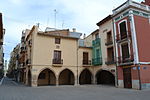Burriana (Spanish: [buˈrjana]) or Borriana (Valencian: [boriˈana]) is a municipality in eastern Spain, in the province of Castellón, part of the Valencian Community. Its population exceeds 34,000.
The town is located by the Mediterranean Sea, at the lowest region of the Plana Baixa, surrounded by orange tree fields watered by the Millars River.It has about 15 km of coastline, including Borriana's principal beach "El Arenal", one of the most attractive spots, especially during the summer. "El Arenal" has about 2 km of seashore, has been awarded the blue flag, which recognizes its magnificent sand and water thanks to the treatments carried out by the city council.
The seaside is 1.5 km from the center of the town. During the summer the seaside population can triple due to vacationers and from locals from the center of the town moving into the seaside. The town is reachable from Castelló de la Plana through the CV-18 or the N-340 routes.
In literature, Burriana is briefly described by James A. Michener in the book, Iberia. As a young man, Michener landed there as a part of a ship crew. The merchant vessel was there to collect oranges for the Scottish marmalade industry. Oranges, after being loaded into metal barrels, were dragged out to sea by bulls.
The town displays many memorial spots dedicated to James A. Michener, such as a street and a sign that quotes one of his passages, where he expresses his first sight of Borriana as he approached land from the sea.











